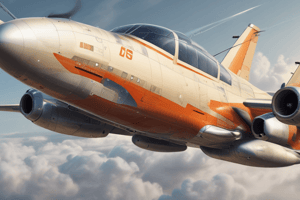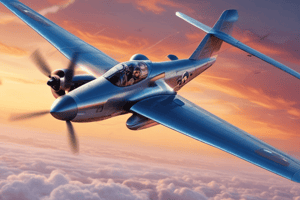Podcast
Questions and Answers
What is the primary focus of the final project in the context of flight?
What is the primary focus of the final project in the context of flight?
- Conducting a comprehensive review of aerodynamic principles
- Designing a new aircraft model
- Applying theoretical principles to real-world scenarios (correct)
- Developing a new navigation system
What is the role of the center of gravity in the equilibrium of flight?
What is the role of the center of gravity in the equilibrium of flight?
- It affects the stability and balance of the aircraft (correct)
- It controls the airspeed of the aircraft
- It determines the overall weight of the aircraft
- It regulates the fuel consumption of the aircraft
What is the purpose of the one-on-one consultations?
What is the purpose of the one-on-one consultations?
- To discuss theoretical principles of flight
- To provide feedback on the final project (correct)
- To conduct a simulation of flight scenarios
- To review the entire course material
What is the main theme of the self-study reading 'Operational Challenges and Aerodynamics'?
What is the main theme of the self-study reading 'Operational Challenges and Aerodynamics'?
What is the ultimate goal of the course, as described in the briefing?
What is the ultimate goal of the course, as described in the briefing?
What is the significance of drag in the context of flight?
What is the significance of drag in the context of flight?
What is the purpose of the previous lessons in the context of the final project?
What is the purpose of the previous lessons in the context of the final project?
What is the main challenge in applying theoretical principles to real-world scenarios?
What is the main challenge in applying theoretical principles to real-world scenarios?
What is the significance of the phrase 'Keep your eyes on the horizon and your mind in the clouds of knowledge'?
What is the significance of the phrase 'Keep your eyes on the horizon and your mind in the clouds of knowledge'?
What is the expected outcome of the final project, as described in the briefing?
What is the expected outcome of the final project, as described in the briefing?
The final project requires students to design an aircraft from scratch.
The final project requires students to design an aircraft from scratch.
The center of gravity is a critical point that affects the stability of flight.
The center of gravity is a critical point that affects the stability of flight.
The previous lessons are irrelevant to the final project.
The previous lessons are irrelevant to the final project.
The self-study reading 'Operational Challenges and Aerodynamics' focuses on the history of flight.
The self-study reading 'Operational Challenges and Aerodynamics' focuses on the history of flight.
The one-on-one consultations are optional for students.
The one-on-one consultations are optional for students.
The phrase 'Keep your eyes on the horizon and your mind in the clouds of knowledge' is a metaphor for staying focused on the final project.
The phrase 'Keep your eyes on the horizon and your mind in the clouds of knowledge' is a metaphor for staying focused on the final project.
The course is only focused on theoretical principles of flight.
The course is only focused on theoretical principles of flight.
The final project will be evaluated solely on its creativity.
The final project will be evaluated solely on its creativity.
The instructor will not provide feedback on the final projects.
The instructor will not provide feedback on the final projects.
The course is only relevant to students who want to become pilots.
The course is only relevant to students who want to become pilots.
How does the integration of principles from drag to the center of gravity contribute to the success of a flight?
How does the integration of principles from drag to the center of gravity contribute to the success of a flight?
What is the primary purpose of the previous lessons in the context of the final project?
What is the primary purpose of the previous lessons in the context of the final project?
How do the concepts explored in the course come alive in real-world applications?
How do the concepts explored in the course come alive in real-world applications?
What is the significance of operational planning in the context of aerodynamics?
What is the significance of operational planning in the context of aerodynamics?
What is the instructor's role in the one-on-one consultations?
What is the instructor's role in the one-on-one consultations?
What is the ultimate goal of the course, as described in the briefing?
What is the ultimate goal of the course, as described in the briefing?
How does the instructor envision students approaching the final project?
How does the instructor envision students approaching the final project?
What is the significance of the phrase 'Let's pat our charts and logs aside' in the context of the briefing?
What is the significance of the phrase 'Let's pat our charts and logs aside' in the context of the briefing?
What is the primary challenge in applying theoretical principles to real-world scenarios?
What is the primary challenge in applying theoretical principles to real-world scenarios?
What is the instructor's tone and attitude towards the students' final projects?
What is the instructor's tone and attitude towards the students' final projects?
Flashcards are hidden until you start studying
Study Notes
Ground Effect
- Ground effect is a phenomenon that affects aircraft performance during critical phases of takeoff and landing.
- It provides a cushion of air, but demands finesse and adaptability from pilots.
- Pilots must adapt to the ground effect to ensure a safe and efficient flight operation.
Directional Stability
- Directional stability is critical in aircraft design, ensuring the path remains true.
- Elements such as vertical fins and the sweepback angle of wings contribute to maintaining directional stability.
Wing Shapes
- Different wing designs are used in aviation, each with unique aerodynamic properties.
- Examples include rectangular wings, tapered designs, and others.
- The choice of wing shape depends on the specific aircraft type and its intended use.
Climb and Descent Dynamics
- Climbs and descents involve a ballet of forces and principles.
- Pilots must understand the principles governing these maneuvers to ensure safe and efficient flight operations.
Propeller Aerodynamics
- Propellers operate on specific principles, with aerodynamic characteristics that affect their performance.
- Factors such as design, pitch, and angle of attack influence propeller efficiency.
- Optimizing propeller performance is crucial for efficient flight operations.
Load Factor
- Load factor is a critical concept in aircraft maneuverability, influencing stall speeds and flight safety.
- It is essential to understand load factor to ensure safe and efficient flight operations.
Center of Gravity
- The center of gravity plays a critical role in maintaining aircraft equilibrium.
- Its impact on aircraft performance and flight dynamics is significant, and managing it within safe operational limits is essential.
- Shifting the center of gravity fore and aft affects the balance of flight.
Ground Effect
- Ground effect is a phenomenon that affects aircraft performance during critical phases of takeoff and landing.
- It provides a cushion of air, but demands finesse and adaptability from pilots.
- Pilots must adapt to the ground effect to ensure a safe and efficient flight operation.
Directional Stability
- Directional stability is critical in aircraft design, ensuring the path remains true.
- Elements such as vertical fins and the sweepback angle of wings contribute to maintaining directional stability.
Wing Shapes
- Different wing designs are used in aviation, each with unique aerodynamic properties.
- Examples include rectangular wings, tapered designs, and others.
- The choice of wing shape depends on the specific aircraft type and its intended use.
Climb and Descent Dynamics
- Climbs and descents involve a ballet of forces and principles.
- Pilots must understand the principles governing these maneuvers to ensure safe and efficient flight operations.
Propeller Aerodynamics
- Propellers operate on specific principles, with aerodynamic characteristics that affect their performance.
- Factors such as design, pitch, and angle of attack influence propeller efficiency.
- Optimizing propeller performance is crucial for efficient flight operations.
Load Factor
- Load factor is a critical concept in aircraft maneuverability, influencing stall speeds and flight safety.
- It is essential to understand load factor to ensure safe and efficient flight operations.
Center of Gravity
- The center of gravity plays a critical role in maintaining aircraft equilibrium.
- Its impact on aircraft performance and flight dynamics is significant, and managing it within safe operational limits is essential.
- Shifting the center of gravity fore and aft affects the balance of flight.
Ground Effect
- Ground effect is a phenomenon that affects aircraft performance during critical phases of takeoff and landing.
- It provides a cushion of air, but demands finesse and adaptability from pilots.
- Pilots must adapt to the ground effect to ensure a safe and efficient flight operation.
Directional Stability
- Directional stability is critical in aircraft design, ensuring the path remains true.
- Elements such as vertical fins and the sweepback angle of wings contribute to maintaining directional stability.
Wing Shapes
- Different wing designs are used in aviation, each with unique aerodynamic properties.
- Examples include rectangular wings, tapered designs, and others.
- The choice of wing shape depends on the specific aircraft type and its intended use.
Climb and Descent Dynamics
- Climbs and descents involve a ballet of forces and principles.
- Pilots must understand the principles governing these maneuvers to ensure safe and efficient flight operations.
Propeller Aerodynamics
- Propellers operate on specific principles, with aerodynamic characteristics that affect their performance.
- Factors such as design, pitch, and angle of attack influence propeller efficiency.
- Optimizing propeller performance is crucial for efficient flight operations.
Load Factor
- Load factor is a critical concept in aircraft maneuverability, influencing stall speeds and flight safety.
- It is essential to understand load factor to ensure safe and efficient flight operations.
Center of Gravity
- The center of gravity plays a critical role in maintaining aircraft equilibrium.
- Its impact on aircraft performance and flight dynamics is significant, and managing it within safe operational limits is essential.
- Shifting the center of gravity fore and aft affects the balance of flight.
Studying That Suits You
Use AI to generate personalized quizzes and flashcards to suit your learning preferences.




